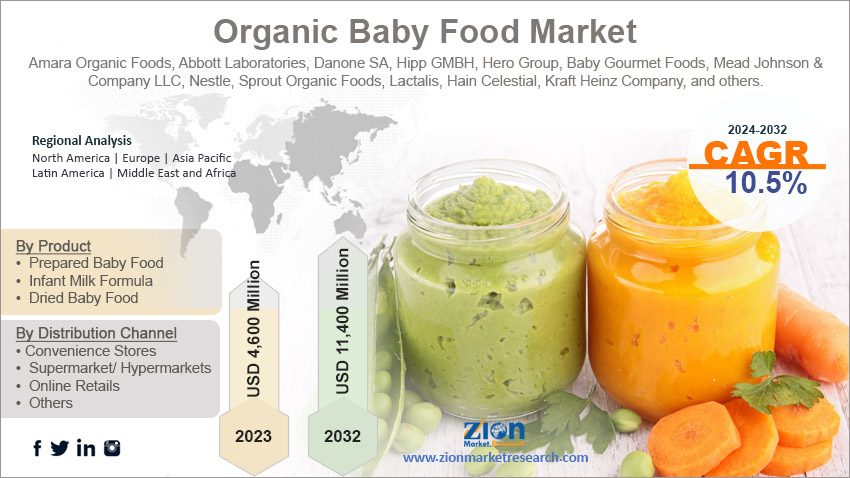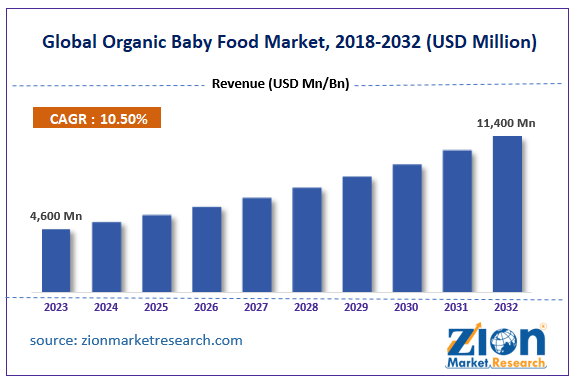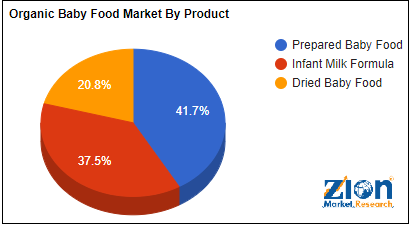Organic Baby Food Market Size, Share, Industry Analysis, Trends, Growth, Forecasts, 2032

Organic Baby Food Market By Product (Prepared Baby Food, Infant Milk Formula and Dried Baby Food), By Distribution Channel (Convenience Stores, Supermarket/ Hypermarkets, Online Retails, and Others), and By Region - Global and Regional Industry Overview, Market Intelligence, Comprehensive Analysis, Historical Data, and Forecasts 2024 - 2032
| Market Size in 2023 | Market Forecast in 2032 | CAGR (in %) | Base Year |
|---|---|---|---|
| USD 4,600 Million | USD 11,400 Million | 10.5% | 2023 |
Organic Baby Food Industry Prospective:
The global organic baby food market size was worth around USD 4,600 million in 2023 and is predicted to grow to around USD 11,400 million by 2032 with a compound annual growth rate (CAGR) of roughly 10.5% between 2024 and 2032.
Organic Baby Food Market: Overview
Organic agricultural procedures are used to cultivate the components used to make organic baby food. Using strategies like crop rotation, cover crops, and decreased tillage, these methods put biodiversity, soil health, and water conservation first. Organic farms use natural substitutes like compost and biological pest management in place of petrochemical fertilizers, herbicides, and insecticides.
The organic baby food market is driven by various factors including growing consumer awareness, rising disposable income, growing health and nutrition concerns, increasing investment in organic practices, rising product innovation and many others.
Key Insights
- As per the analysis shared by our research analyst, the global organic baby food market is estimated to grow annually at a CAGR of around 10.5% over the forecast period (2024-2032).
- In terms of revenue, the global organic baby food market size was valued at around USD 4,600 million in 2023 and is projected to reach USD 11,400 million, by 2032.
- The growing consumer awareness about organic foods is driving the market growth during the forecast period.
- Based on the product, the infant milk formula segment is expected to grow at a significant rate during the forecast period.
- Based on the distribution channel, the supermarket/ hypermarkets segment is expected to hold the largest market share during the forecast period.
- Based on region, the Asia Pacific is expected to dominate the market over the projected period.
 Request Free Sample
Request Free Sample
Organic Baby Food Market: Growth Drivers
Growing consumer awareness drives market growth
The increasing consumer awareness among parents about the health risks associated with conventional baby food such as pesticides, hormones, and genetically modified ingredients. As parents are more aware of the benefits of organic farming, they are increasingly opting for organic baby food options. For instance, surveys conducted by the National Agricultural Statistics Service in 2011 and 2021, according to USDA: During 2011–21, certified organic cropland acres expanded by 79 percent to 3.6 million acres, while pastureland/rangeland acres declined by 22 percent to 1.3 million acres. Additionally, certified operations increased by more than 90 percent to 17,445 farms. Thus, the aforementioned stats are driving the market growth during the forecast period.
Organic Baby Food Market: Restraints
High costs hamper market growth
The market for organic infant food is confronted with difficulties since organic goods are more expensive and have a shorter shelf life. Even though there is a growing consumer demand for organic infant food, there are significant logistical and financial challenges that make steady market expansion difficult. Because organic agricultural standards must be strictly followed to produce organic baby food, the expenses associated with this process are greater than with conventional ones.
This entails avoiding synthetic pesticides and genetically modified organisms, using organic fertilizers, and using specialist procedures. These elements lead to higher production costs, which are eventually transferred to customers. Because of this, parents on a tight budget are discouraged from selecting organic baby food over more reasonably priced conventional options due to its high price.
Organic Baby Food Market: Opportunities
Rising product launches provide a potential opportunity for market growth
The rising product launches are expected to offer a potential opportunity for the organic baby food market during the forecast period. For instance, in April 2022, the new Plant-tastic range of carbon-neutral, plant-protein baby food from Nestlé was unveiled. Plant-tastic offers a range of nutrient-dense, plant-based meals, snacks, and pouches that are all organic. Lentils, black beans, navy beans, and chickpeas are among the beans included in every Plant-tastic meal.
Organic Baby Food Market: Challenges
Short shelf life poses a major challenge for market expansion
Merchants and producers alike have logistical challenges due to the short shelf life of organic infant food. Generally speaking, organic products don't include the artificial preservatives that are present in conventional items. Since organic baby food doesn't include preservatives, it's more prone to bacterial contamination and spoiling, thus careful handling and storage are required. Quick rotation is necessary, but it also complicates supply chain management and raises the possibility of product waste, which puts companies in a difficult financial position.
Organic baby food may only be available to a small market due to its high price and limited shelf life, which might exclude a sizable percentage of customers who are more financially constrained. The industry's potential for widespread acceptance is hampered by the limited market penetration and reach overall.
Organic Baby Food Market: Segmentation
The global organic baby food industry is segmented based on product, distribution channel and region.
Based on the product, the global organic baby food market is bifurcated into prepared baby food, infant milk formula and dried baby food. The infant milk formula segment is expected to grow at a significant rate during the forecast period. The segment growth is attributed to the increasing product innovation and launches. For instance, in November 2023, Wyeth Nutrition declared that two human milk oligosaccharides (HMOs) will be added to its first-ever illuma HMO Growing-up newborn formula in China. Made in the company's GMP-level facilities in Suzhou, this product is intended for newborns older than three years old. Presently, Illuma is the first foreign business to launch an HMO baby formula in China. October 7, 2023, saw China's National Health Commission approve the two HMOs as new food additives. Clinical investigations have indicated that the two HMOs in the new Illuma assist in balancing gut microbiota, lower the risk of respiratory infections and bronchitis, and lessen the need for antibiotics and fever reducers. Additionally, the Illuma HMO Growing-up Formula now includes 35 essential nutrients. In addition to strengthening immunity, these nutrients support eye development, enhance brain development, and meet a variety of other nutritional needs for children's growth.
Based on distribution channels, the global organic baby food industry is categorized into convenience stores, supermarkets/ hypermarkets, online retails and others. The supermarket/ hypermarkets segment is expected to hold the largest market share during the forecast period. When buying groceries, consumer goods, and infant care products, customers gravitate toward hypermarkets and supermarkets since they can physically inspect the products. The upgraded global distribution channel networks are projected to keep supermarkets and hypermarkets dominant throughout the projection period. On the other hand, the online retail segment is expected to grow at the highest CAGR during the forecast period. Online retail platforms provide parents with the convenience of browsing and purchasing organic baby food products from the comfort of their homes. This is particularly appealing to busy parents who may not have the time to visit physical stores. Moreover, they offer a diverse range of organic baby food products, allowing parents to explore various brands, flavors, and formulations. Customers can find products that suit their tastes and the unique dietary needs of their infants due to this wide selection. Thus, this is expected to drive the market growth.
Organic Baby Food Market: Report Scope
| Report Attributes | Report Details |
|---|---|
| Report Name | Organic Baby Food Market |
| Market Size in 2023 | USD 4,600 Million |
| Market Forecast in 2032 | USD 11,400 Million |
| Growth Rate | CAGR of 10.5% |
| Number of Pages | 226 |
| Key Companies Covered | Amara Organic Foods, Abbott Laboratories, Danone SA, Hipp GMBH, Hero Group, Baby Gourmet Foods, Mead Johnson & Company LLC, Nestle, Sprout Organic Foods, Lactalis, Hain Celestial, Kraft Heinz Company, and others. |
| Segments Covered | By Product, By Distribution Channel, and By Region |
| Regions Covered | North America, Europe, Asia Pacific (APAC), Latin America, Middle East, and Africa (MEA) |
| Base Year | 2023 |
| Historical Year | 2018 to 2022 |
| Forecast Year | 2024 - 2032 |
| Customization Scope | Avail customized purchase options to meet your exact research needs. Request For Customization |
Regional Analysis
The Asia Pacific is expected to dominate the market over the projected period
The Asia Pacific is expected to dominate the market over the projected period. The market growth in the region is attributed to the increasing e-commerce sector. For instance, the Indian government's Economic Survey 2022–2023 projects that the e-commerce sector will expand at a rate of 18% a year until 2025. The government's increasing emphasis on e-commerce through programs like the ONDC and PM Gati Shakti National Master Plan, together with the industry's expansion, has given millions of Indian enterprises hope for the future of e-commerce.
Besides, Europe is expected to grow at the highest CAGR during the forecast period. Growing demand for packaged organic food items because of their excellent nutritional content and environmental friendliness has predicted market expansion. Furthermore, the manufacturers' creation of novel mixes that combine well with organic baby food has predicted the growth of the market in this area throughout the projection year.
Organic Baby Food Market: Competitive Analysis
The global organic baby food market is dominated by players like:
- Amara Organic Foods
- Abbott Laboratories
- Danone SA
- Hipp GMBH
- Hero Group
- Baby Gourmet Foods
- Mead Johnson & Company LLC
- Nestle
- Sprout Organic Foods
- Lactalis
- Hain Celestial
- Kraft Heinz Company
The global organic baby food market is segmented as follows:
By Product
- Prepared Baby Food
- Infant Milk Formula
- Dried Baby Food
By Distribution Channel
- Convenience Stores
- Supermarket/ Hypermarkets
- Online Retails
- Others
By Region
- North America
- The U.S.
- Canada
- Europe
- France
- The UK
- Spain
- Germany
- Italy
- Rest of Europe
- Asia Pacific
- China
- Japan
- India
- South Korea
- Southeast Asia
- Rest of Asia Pacific
- Latin America
- Brazil
- Mexico
- Rest of Latin America
- Middle East & Africa
- GCC
- South Africa
- Rest of Middle East & Africa
Table Of Content
Methodology
FrequentlyAsked Questions
Organic agricultural procedures are used to cultivate the components used to make organic baby food. Using strategies like crop rotation, cover crops, and decreased tillage, these methods put biodiversity, soil health, and water conservation first. Organic farms use natural substitutes like compost and biological pest management in place of petrochemical fertilizers, herbicides, and insecticides.
The organic baby food market is driven by various factors including growing consumer awareness, rising disposable income, growing health and nutrition concerns, increasing investment in organic practices, rising product innovation and many others.
According to the report, the global market size was worth around USD 4,600 million in 2023 and is predicted to grow to around USD 11,400 million by 2032.
The global organic baby food market is expected to grow at a CAGR of 10.5% during the forecast period.
The global organic baby food market growth is expected to be driven by the Asia Pacific. It is currently the world’s highest revenue-generating market due to the growing e-commerce industry.
The global organic baby food market is dominated by players like Amara Organic Foods, Abbott Laboratories, Danone SA, Hipp GMBH, Hero Group, Baby Gourmet Foods, Mead Johnson & Company LLC, Nestle, Sprout Organic Foods, Lactalis, Hain Celestial and Kraft Heinz Company among others.
The organic baby food market report covers the geographical market along with a comprehensive competitive landscape analysis. It also includes cash flow analysis, profit ratio analysis, market basket analysis, market attractiveness analysis, sentiment analysis, PESTLE analysis, trend analysis, SWOT analysis, trade area analysis, demand & supply analysis, Porter’s five forces analysis, and value chain analysis.
HappyClients
Zion Market Research
Tel: +1 (302) 444-0166
USA/Canada Toll Free No.+1 (855) 465-4651
3rd Floor,
Mrunal Paradise, Opp Maharaja Hotel,
Pimple Gurav, Pune 411061,
Maharashtra, India
Phone No +91 7768 006 007, +91 7768 006 008
US OFFICE NO +1 (302) 444-0166
US/CAN TOLL FREE +1 (855) 465-4651
Email: sales@zionmarketresearch.com
We have secured system to process your transaction.
Our support available to help you 24 hours a day, five days a week.
Monday - Friday: 9AM - 6PM
Saturday - Sunday: Closed







